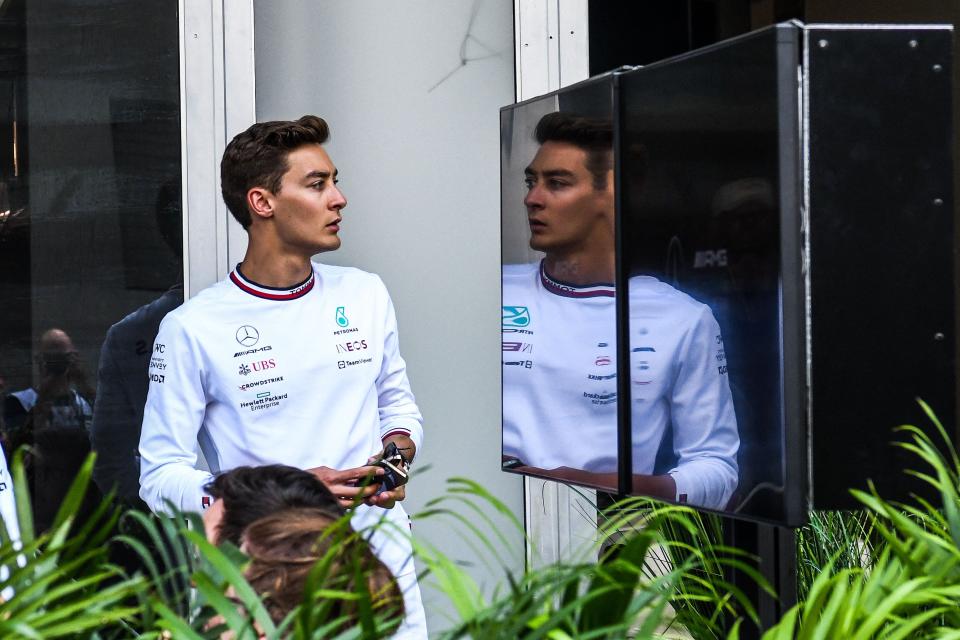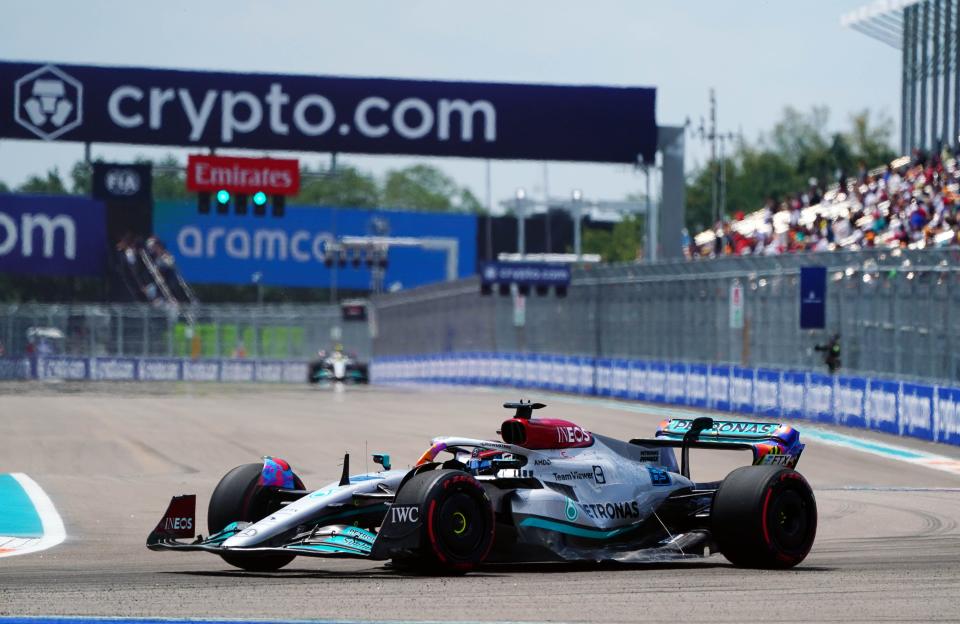George Russell opens up about Formula 1 driving's physical rigors, being teammates with Lewis Hamilton
In terms of resources available, George Russell sits at the top of the Formula 1 mountain.
In his first season driving for Mercedes, the 24-year-old is just one – albeit the most important – member of a 1,200-person team.
Russell thinks back to his karting days, when it that "team" was much smaller.
"It was me, my mother and my father. They were my engineers," Russell told USA TODAY Sports. "My father was the mechanic. My mother was writing down all the data and the turns of every single place that we went to. And it was the three of us."
The Russell family had a head start in the karting world, which Russell believes led him on his Formula 1 path. He can thank brother, Benjy, who is 11 years older and influenced the family's interest in racing.

"He was a really successful and really great go-kart driver. But ultimately, he just started too late," said Russell, who is fourth in the standings entering Sunday's Miami Grand Prix. "The guys who are the best start around age 6 or 7.
"I feel so fortunate that he learned so much and went through a lot of the struggles of learning the ropes and he could just pass that down to me, so I just almost leap-frogged a lot of these errors I may have made as an eight-year-old child."
FORMULA 1: Believed in U.S. growth. 'Spectacle' of Miami Grand Prix is its reward.
COMING TO AMERICA: How the Formula 1 race arrived in Miami
BETTING GUIDE: F1 legend Lewis Hamilton is underdog on new track
Russell spoke with USA TODAY about the physical rigors of driving and what it's like being teammates with seven-time champion Lewis Hamilton.
Questions and answers have been lightly edited for clarity.
USA TODAY: What kind of training do you do to get ready for races?
George Russell: “I think a lot of people think we sit there with a massage seat and air conditioning and a cupholder. The physical side of it is one side of it. When you’re going around the corner at 180 mph, the force that produces, is just astronomical. On your neck it equates to about 50 kilos of force. And then it goes through your body, your arm, the steering – the force of the car is trying to move you one way, so (using) core strength. And then we’re braking hard … that’s about 180 kilos of force you’re putting through your left leg, which obviously goes into your lower back and glutes. So when you’re sitting there and you have your helmet on, it almost looks like man and machine is one. You don’t sometimes comprehend there’s a human being inside.
I don’t know what the future is to be able to give a fan experience is to allow people to realize what you’re going through, but I remember doing the esports on the online simulator, I wasn’t wearing a helmet obviously. I was in my living room. The camera caught me (and) you could see the focus in (my) eyes. I thought that was really cool.”
USAT: Do you study physics? How do you approach the technical side of driving?
GR: “I’d say my technical knowledge is good enough but the most important thing in Formula 1 is that you have experts in their field and you need to trust those experts to do what they do best. You can’t step on other people’s toes. As a driver, you need to give them feedback and point them in the right direction and pinpoint accurately what the issue is when describing it.
I think one thing that’s important for drivers is communication skills. Because you could describe the same problem to 10 different people, and if you don’t describe it the right way, there could be 10 different takes from your limitation. But as I said, we have a number of incredibly brilliant engineers, designers throughout the whole factory. The team is filled with them. Basically, you need great leadership to direct the troops in their approach, to tackle these problems, but then leave them to do what they do best – whether it’s designing or engineering.
From my side, it’s very important to sort of learn a little bit as you go along the way. Not only to give the feedback, but say ‘Actually, I believe making this specific change to the car will benefit, for these specific reasons.’ And that’s where having the engineering knowledge is good.”
USAT: What’s it been like being teammates with Lewis Hamilton and joining Mercedes?
GR: “It’s been pretty surreal in ways, racing alongside Lewis. Obviously there’s that photograph of myself queuing up for his autograph back in 2009 I think it was. He was a superhero at the time to me. You don’t believe these people are real. You watch them on the television, you idolize them, and then suddenly you’re teammates, on-track mates, off-track. I think just as you grow up, adn I’ve gotten into the bubble of F1, you learn that these ‘superheroes’ are just normal people at hte end of the day. They’re extremely talented at what they do. But they are still just normal people. There’s so much scrutiny on a guy like Louis. He’s achieved so much. The pressures and the scrutiny are enormous. But when the doors are closed and the cameras are off, he’s just a normal bloke and it sort of brings it all back to reality.”
USAT: When you transition from a place like Williams, where you obviously had a good experience and memories, to a place like Mercedes, how much of a difference does that make, just in terms of resources?
GR: “I think what you quickly learn with a team like Mercedes is that no matter the cost, it’s ‘Do whatever it takes.’ During my time at Williams, there were huge financial restrictions and limitations. This was a team struggling to survive. The purpose of the years I spent there was surviving. Because the team was very close to bankruptcy and 700 people would have lost their jobs. Whereas you go 30 miles across to Brackley, with a team of 2,000 people, the resource was almost infinite and the innovation is like nothing you’ve seen before and just striving to get better, striving to innovate, striving to win. I would say that’s the biggest difference.”
USAT: Coming off of Emilio Romagna, where you had two tough races in your career before a (fourth-place finish) leading into Miami, what does that do for your confidence?
GR: “That’s a question I’ve been asked a few times.That circuit probably contributed to 50% of my darkest days in Formula 1, so obviously to get a relatively good result was nice to get the monkey on my back almost, but I don’t really believe in those sort of coincidences. My mentality that weekend was no different. I was going in there full gas, max attack, and you can’t dwell on the past if you want to move forward. You can’t let it take energy from you. Those moments, as it happened, probably contributed to making me a better driver today, a stronger driver. It’s how you deal with those difficult moments, how you pull through. Success is great. But failure is sort of necessary.”
USAT: I also heard you’re a fan of “Fresh Prince” and “Friends”. How did you come across those?
GR: “The first one I came across was ‘Friends.’ It was always on the television on Comedy Central, I think, in the UK. It must have been on 24/7. They should have rebranded the channel to ‘Friends TV.’ I went through every single episode, probably – I was pretty young, 14 to 16, 17. Easy TV to watch when I came home from school or a race, just had it on in the background. Recently, I watched ‘Fresh Prince’ for the first time.”
Follow Chris Bumbaca on Twitter @BOOMbaca.

This article originally appeared on USA TODAY: George Russell: Formula 1 driver on Lewis Hamilton, racing Mercedes
